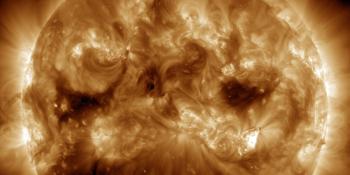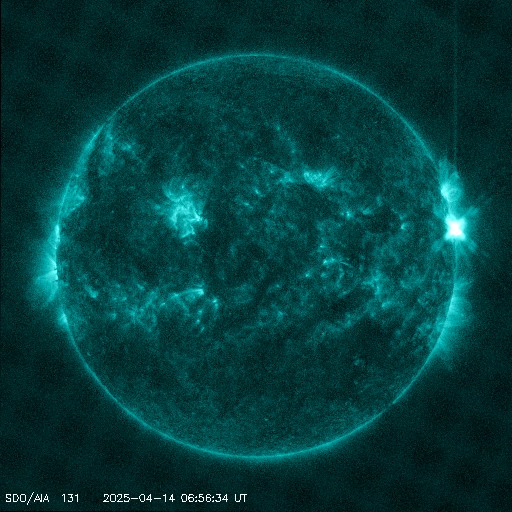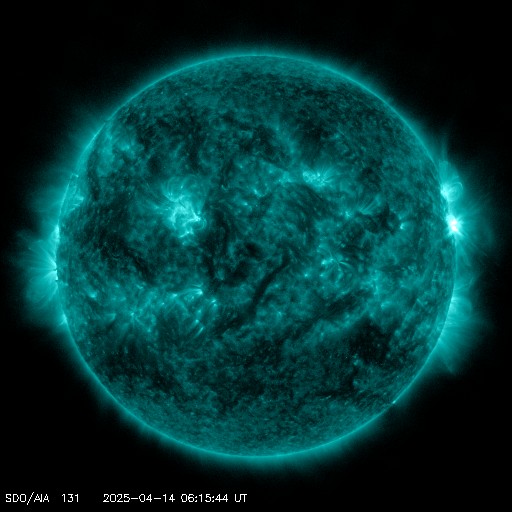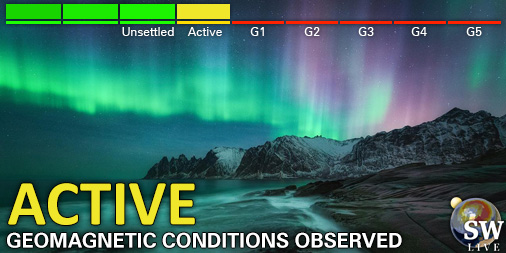Viewing archive of Friday, 2 December 2005
Solar activity report
Any mentioned solar flare in this report has a scaling factor applied by the Space Weather Prediction Center (SWPC). Because of the SWPC scaling factor, solar flares are reported as 42% smaller than for the science quality data. The scaling factor has been removed from our archived solar flare data to reflect the true physical units.
Report of Solar-Geophysical Activity 2005 Dec 02 2204 UTCPrepared by the NOAA © SWPC and processed by SpaceWeatherLive.com
Joint USAF/NOAA Report of Solar and Geophysical Activity
SDF Number 336 Issued at 2200Z on 02 Dec 2005IA. Analysis of Solar Active Regions and Activity from 01-2100Z to 02-2100Z
Solar activity increased to high levels today. Region
826 (S02E09) continues to show strong growth in magnetic complexity
and sunspot area. Magnetic analysis shows a strong east-west
neutral line through the delta spot in the geometric center of the
sunspot cluster. Sunspot area more than doubled since yesterday and
measures 490 millionths in white light analysis. Region 826
produced two major flares during the period, the largest was an
M7/1n flare that occurred at 02/1012Z, and had an associated
Tenflare (490 sfu), and a Type II radio sweep with an estimated
shock velocity of 824 km/sec. There was a very faint partial halo
CME following this flare, which was first seen on LASCO imagery at
02/1054Z. The second major flare today was an M6 x-ray event
occurring at 02/0252Z which had an associated Tenflare (460 sfu).
Regions 829 (N11E02) and 830 (N14E78) were numbered today.
IB. Solar Activity Forecast
Solar activity is expected to be at
moderate to high levels. Region 826 is expected to continue to
produce major flares.
IIA. Geophysical Activity Summary 01-2100Z to 02-2100Z
The geomagnetic field ranged from quiet to active levels. An
isolated minor storm period was observed at the Boulder magnetometer
between 01/2100 and 2400Z. The greater than 2 MeV electron flux at
geosynchronous orbit reached high levels today.
IIB. Geophysical Activity Forecast
The geomagnetic field is
expected to range from quiet to active levels throughout the period.
The high speed coronal hole stream is expected to move out of
geoeffective position on 03 December. A weak transient passage from
the partial halo CME that occurred today, may lead to isolated minor
storm conditions late on 04 or early on 05 December.
III. Event Probabilities 03 Dec to 05 Dec
| Class M | 60% | 60% | 60% |
| Class X | 25% | 25% | 25% |
| Proton | 10% | 10% | 10% |
| PCAF | green | ||
IV. Penticton 10.7 cm Flux
Observed 02 Dec 106 Predicted 03 Dec-05 Dec 110/110/110 90 Day Mean 02 Dec 085
V. Geomagnetic A Indices
Observed Afr/Ap 01 Dec 012/013 Estimated Afr/Ap 02 Dec 012/015 Predicted Afr/Ap 03 Dec-05 Dec 010/015-010/012-012/015
VI. Geomagnetic Activity Probabilities 03 Dec to 05 Dec
| A. Middle Latitudes | |||
|---|---|---|---|
| Active | 20% | 20% | 25% |
| Minor storm | 05% | 05% | 10% |
| Major-severe storm | 01% | 01% | 05% |
| B. High Latitudes | |||
|---|---|---|---|
| Active | 30% | 25% | 30% |
| Minor storm | 15% | 10% | 15% |
| Major-severe storm | 10% | 05% | 10% |
All times in UTC
Current data suggests there is a slight possibility for aurora to appear at the following high latitude regions in the near future
TórshavnOulu, Rovaniemi
Trondheim
Luleå, Umeå
Latest news
Latest forum messages
2025/04/12-13 Filament CMEs 2025/04/16 G2 Watch 38Incoming & Unnumbered Active Regions 1700Unspecified geomagnetic activity 2258AR 4055 98Potential AR4062 8
More topicsSupport SpaceWeatherLive.com!
A lot of people come to SpaceWeatherLive to follow the Sun's activity or if there is aurora to be seen, but with more traffic comes higher server costs. Consider a donation if you enjoy SpaceWeatherLive so we can keep the website online!

Latest alerts
07:09 UTC - Solar flare
Moderate M4.28 flare from sunspot region 4055
06:48 UTC - Radio Blackout
Minor R1 radio blackout in progress (≥M1 - current: M1.53)
06:24 UTC - Solar flare
Moderate M1.49 flare from sunspot region 4055
06:06 UTC - Radio Blackout
Minor R1 radio blackout in progress (≥M1 - current: M1.16)
04:45 UTC - Geomagnetic activity
Active geomagnetic conditions (Kp4) Threshold Reached: 04:29 UTC
Space weather facts
| Last X-flare | 2025/03/28 | X1.1 |
| Last M-flare | 2025/04/14 | M4.2 |
| Last geomagnetic storm | 2025/04/06 | Kp5 (G1) |
| Spotless days | |
|---|---|
| Last spotless day | 2022/06/08 |
| Monthly mean Sunspot Number | |
|---|---|
| March 2025 | 134.2 -20.4 |
| April 2025 | 132.1 -2.1 |
| Last 30 days | 130.6 -13.6 |





